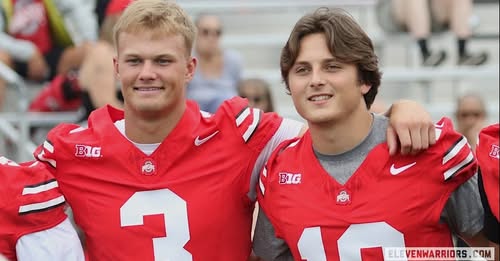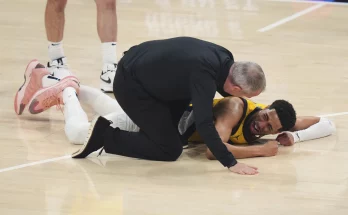The offseason is where champions are built—not on the scoreboard but in the shadows, long before the stadium lights ever turn on. For Ohio State’s quarterback duo of Julian Sayin and Lincoln Kienholz, that sentiment is not just a cliché; it’s a code they’ve lived by this summer. As fall camp draws nearer and the Buckeyes prepare for a season with national championship expectations, Sayin and Kienholz have taken divergent but complementary paths toward maximizing their potential and competing for their place in Ryan Day’s quarterback room. While Sayin focused intensely on mastering the mental side of the game, Kienholz attacked the weight room and the track with a vengeance, determined to transform his frame and athleticism into a tangible on-field advantage. Their offseason evolutions paint a picture of two elite talents growing into future stars through entirely different means, and in the process, pushing each other to new heights.
Julian Sayin arrived in Columbus with the kind of fanfare that usually precedes greatness. A five-star quarterback out of California, Sayin committed to Alabama before flipping to Ohio State, choosing development and system fit over prestige alone. In doing so, he signaled a deep understanding of what it would take to succeed at the next level. This offseason, Sayin leaned heavily into the cerebral side of football. By his own admission, he’s spent more time than ever breaking down film—not just of his own reps but of NFL quarterbacks, previous Ohio State signal-callers like C.J. Stroud, and opposing college defenses. It’s a sign of maturity beyond his years. While arm strength and mobility often dominate recruiting conversations, Sayin knows that processing speed, coverage recognition, and decision-making separate the good from the great in college football. His focus on these aspects hasn’t gone unnoticed by Ohio State coaches, who’ve praised his growth in the meeting room and on the whiteboard.
There’s an old saying that the game slows down for great quarterbacks. That doesn’t just happen with time—it happens through hours of detailed preparation. Sayin has taken that to heart. He reportedly watches film every morning before practice and meets regularly with offensive coordinator Chip Kelly to go over nuances in play design and defensive manipulation. One insider described Sayin as “obsessed” with understanding leverage, route timing, and how to read post-snap rotations. That obsession may be his most powerful tool in climbing the depth chart.
What makes Sayin’s progress even more impressive is how quickly he’s been able to digest and apply complex concepts. Coming from a high school offense that featured spread principles but didn’t always demand full-field reads, Sayin has had to adapt to a system where pre-snap motion, play-action deception, and layered progressions are the norm. In spring practices, he started to flash the ability to look off safeties and fit the ball into tight windows. By the time summer workouts rolled around, Sayin was consistently staying after practice to get in extra mental reps, walking through scenarios with teammates and calling out blitz pickups to offensive linemen as if he were already a starter. It’s the kind of behind-the-scenes leadership that sets the foundation for on-field dominance.
Meanwhile, Lincoln Kienholz has attacked the offseason with a different but equally vital purpose. After a freshman year spent largely on the sidelines, learning and absorbing the system, Kienholz knew that his physical profile needed to evolve to compete at the highest level. Listed at 6-foot-2 and just under 200 pounds last year, he entered winter workouts determined to add muscle, increase his top-end speed, and improve his burst in the pocket. According to strength staff reports, he’s succeeded on all three fronts. Kienholz has added close to 15 pounds of lean muscle without sacrificing quickness, posting some of the fastest 10-yard split times among quarterbacks and registering a vertical leap increase of nearly three inches. Simply put, he’s more explosive and more durable than he was just a few months ago.
For Kienholz, the physical development was about more than aesthetics or meeting strength benchmarks—it was about functionality. He’s always had sneaky athleticism, the kind that shows up when plays break down, but now he’s shaping that raw ability into consistent weaponry. Reports from team scrimmages indicate that Kienholz has been difficult to bring down in the backfield, with a faster first step and greater core stability that allow him to escape pressure and reset more quickly. There’s also been an uptick in his deep ball accuracy, a benefit of improved lower-body strength and follow-through mechanics. Throwing on the move, which was already a strong suit, now looks even more natural thanks to a stronger base and more confidence in his legs.
That confidence has translated into leadership, too. While Sayin has taken on the cerebral mentorship role, Kienholz has emerged as a tone-setter in the weight room and on the practice field. Teammates describe him as someone who “goes full speed on every rep” and “talks trash in the best way possible”—a competitor who demands more from those around him by raising the standard of effort. During summer 7-on-7 sessions, Kienholz was often seen rallying receivers after miscues and encouraging offensive linemen after busted protections. His voice, once quiet in his first year on campus, is now a trusted part of the team’s internal engine.
The dynamic between Sayin and Kienholz is what makes the situation so compelling. There is competition, of course, but there is also mutual respect. Both understand that the other brings something unique to the table. Sayin sees the game like a chessboard, diagnosing moves before they happen. Kienholz plays like a point guard, fast-twitch and fearless, improvising when plays break down. In many ways, they reflect different eras of quarterbacking—Sayin more traditional and cerebral, Kienholz more modern and kinetic. Yet together, they create an environment where both styles can thrive and sharpen one another.
This has also presented Ryan Day and Chip Kelly with an enviable challenge: how do you balance development with urgency when you have two quarterbacks growing in such different but promising ways? Day has always emphasized that the best players will play, but he’s also shown a willingness to use multiple quarterbacks situationally if it helps the team win. With Sayin’s command of the system and Kienholz’s growing dual-threat ability, Ohio State may be in a position to leverage both skill sets throughout the year, even if one wins the starting job outright.
That’s not to suggest a full-on quarterback rotation is likely—Ohio State prefers stability under center—but the versatility and depth at the position give the Buckeyes flexibility in how they attack defenses. Whether it’s using Sayin in two-minute drills where precision matters most, or inserting Kienholz in red zone packages to exploit defensive over-pursuit, the possibilities are endless. More importantly, both quarterbacks seem to understand their role in the bigger picture: push each other, improve individually, and be ready when the opportunity comes.
Sayin’s mental gains and Kienholz’s physical transformation don’t just bode well for their personal development—they signal something even greater for the program. In an era when players transfer at the first sign of competition, both have doubled down on their commitment to growth at Ohio State. That’s a testament to the culture in Columbus, a culture where elite recruits aren’t just promised playing time—they’re expected to earn it through work and growth. It also reflects well on the coaching staff, which has fostered an environment where players can thrive on their individual development paths without tearing each other down.
There’s no denying that the battle for the starting job is heating up. But what matters most is that both quarterbacks are rising to the challenge, not retreating from it. Sayin is refining the intangibles that can’t be measured on a stopwatch. Kienholz is enhancing the tangibles that leap off the screen. Together, they represent the future of Ohio State football—a future that is as bright as it is competitive. As fall camp approaches, the spotlight will only intensify. But no matter who ultimately takes the first snap, the Buckeyes know they’ll be in capable hands. Because this offseason, in very different but equally impactful ways, Julian Sayin and Lincoln Kienholz made themselves better. And in doing so, they made Ohio State better too.



